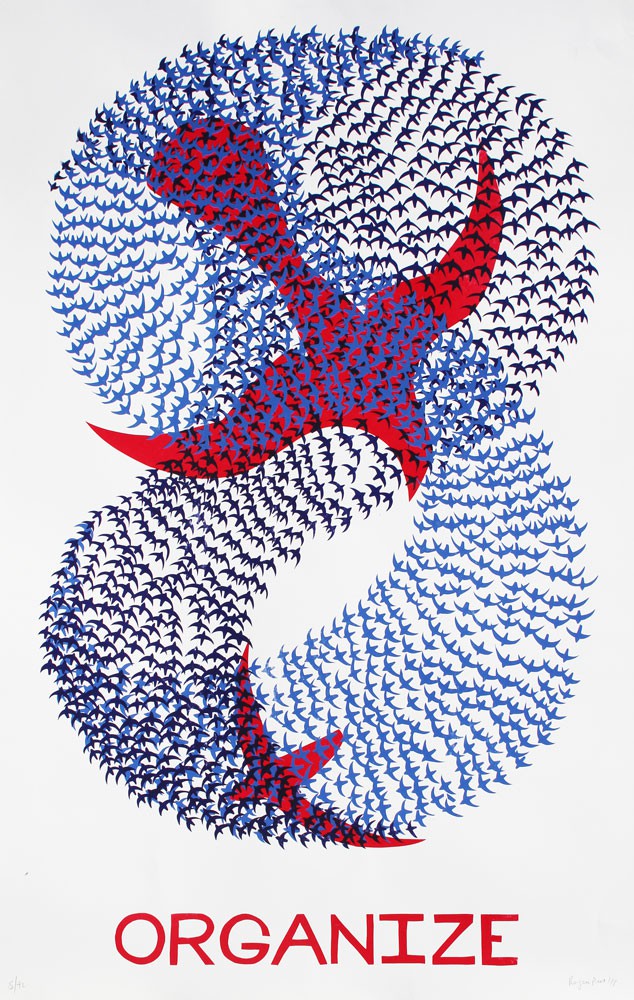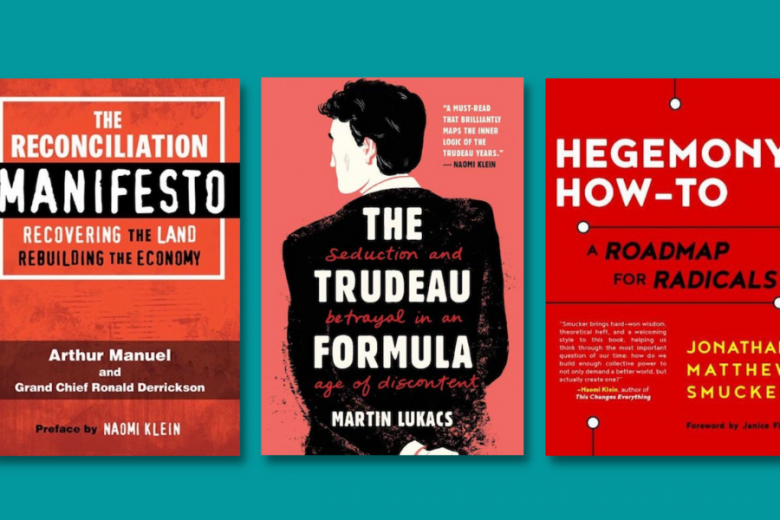“What’s the connection between concrete activities and vision?” This is a provocative question longtime New York housing and HIV/AIDS organizer Michelle O’Brien posed in my interview with her. She was expressing a concern that increasingly preoccupies many radical organizers: How can our activities tangibly build toward achieving social transformation on a large scale? This, fundamentally, is a question of strategy.
What exactly is strategy? Rahula Janowski, a longtime activist in San Francisco, summed it up well: “What’s your goal? What can you do to get there? What are your plans to get there? That’s your strategy.” In this sense, strategy is something we can develop on many different timelines (from days to decades) and scales (from small groups to global movements). In all cases, however, a strategy is a plan or series of plans for moving us from where we are to where we’d like to be.
A major problem in left movements in North America is that we tend to do this sort of planning so infrequently. James Tracy, a housing organizer and writer also in San Francisco, argued that this lack of strategy often results in activists achieving very little. Using a metaphor from a friend, he explained, “Organizing without a strategy is like watching peewee soccer where you throw a ball out and a bunch of little four-year-olds come. They kick the ball, they put everything into it, sometimes they just go crazy with it, with all their energy … and occasionally somebody gets the goal, but you can’t figure out how it happened and you can’t replicate it and you can’t do it better in a more efficient manner.”
This, unfortunately, is what a lot of left political activity looks like. As we struggle, Tracy emphasized, there are no guarantees, but we can improve our possibilities of getting what we want if we’re intentional about what we’re doing. It comes down to a question, he said: “Do you want to have a chance at winning something?”
Barriers to strategy
Many of us involved in movements yearn for strategic discussion. As Toronto-based activist Pauline Hwang put it, “To have some level of dialogue at which these questions are being raised – the questions of long-term direction, the questions of how does our work fit into building the society we want to have after the so-called revolution – having that kind of dialogue is important to me.” This yearning is something I’ve encountered in conversations and workshops with activists across the continent. So why do we have such tremendous difficulty sustaining this kind of dialogue and developing strategy? In my view, there are three major barriers that regularly trip us up.
The first is a tendency toward focusing on principles over plans. This focus is based on a legitimate concern with radicals sacrificing our core values and beliefs in order to win. But focusing exclusively on principles slips into a kind of magical thinking: if we have the right ideas and values, so this goes, everything else will more or less follow. Brooke Lehman, an experienced activist and educator who was involved with Occupy Wall Street in New York, characterized this tendency as an attitude like, “Well, I’m gonna do what I believe in and what feels right to me and just be a piece of this larger whole.”
The trouble is, as Lehman said, “If I can’t articulate what that larger whole is and where that larger whole is going or where it could potentially go, then I’m participating on blind hope, and I think there are a lot of us doing that. And I don’t think you can operate on principles alone. We have to have a strategy, and it has to be a viable one – not just based on an idea of how it could possibly work but we don’t know how to get from here to there.”
One result of this fixation on principles over plans is that activists often spend a lot of time and energy debating whether particular individuals, activities, or organizations are sufficiently “radical” without asking basic questions about how they seek to move us toward actually winning. A focus on political ideas and rhetoric, in this way, eclipses strategic thinking. It also creates a context in which some activists are quick to dismiss any effort – often sloppily using the terms “liberal” and “reformist” – that doesn’t lead directly to the complete destruction of the existing social order. San Francisco direct action organizer David Solnit didn’t mince words about this: “A lot of radicals talk shit about anything short of smashing the state, but they don’t have any idea of how to take necessary steps in that direction.”
If we genuinely want to fundamentally reorganize power in our society, then we have to think long-term about what we’re doing and give up on all-or-nothing answers. This doesn’t mean that we can’t be firm in our politics, but we have to combine this with planning based on what we want to achieve.
A fetish for tactics
The second barrier to developing strategy is a tendency toward fetishizing particular tactics. By tactics, I mean specific forms of collective action such as lobbying politicians, occupying public spaces, going on strike, holding educational events, marching in protests, and street-fighting with cops. Many of us prioritize direct action tactics. These are tactics aimed at directly preventing something from happening (such as stopping an eviction by physically blockading attempts to move people out of a house) or directly making something happen regardless of legality (such as opening up a vacant building so that houseless people can live in it). We value direct action tactics because they involve people collectively recognizing and using their own power rather than appealing to those in power.
The problem is when a particular tactic or bundle of tactics becomes something activists think should be used in any and all situations regardless of the circumstances. As Solnit argued, “It’s like we’re trying to rebuild an engine and we’re ignoring the repair manuals, we’re ignoring the folks down the block who have actually rebuilt 20 or 30 engines. We’re using the same wrenches and ignoring the tool box – the many tactics and tools of movement-building and campaigns. We get stuck: we see a form, like a mass march, a black bloc, or a civil disobedience, and grab onto it – usually on an emotional basis, whatever form feels more powerful to us – without any clue of how are we going to get from here to there or analysis of how power works.” This is fetishism – fixation on particular forms without regard for context.
One of the most troubling outcomes of this is that, as activists and organizers, we end up focusing most of our attention on questions around tactics rather than on how those tactics fit in overall plans to achieve something. This is understandable: it’s much easier to argue about whether particular tactics are valid or effective than it is to create plans to motivate our tactical choices. But the truth is, we can’t evaluate tactics without having a more developed sense of where they are located in a bigger picture. This is the role of strategy.
The crisis treadmill
The third barrier to developing strategy is a tendency toward crisis mode organizing. In Montreal, several people I interviewed self-critically described this as the “Montreal organizing cycle.” Tatiana Gomez, who worked with Solidarity Across Borders, explained, “A lot of our organizing happens in response to emergencies. And so people will do a sprint of organizing over a few months, culminating in a giant action, and then, after the action, there’s little energy left because everyone is burnt.” While this organizing cycle has a specific character in Montreal, it’s actually a widespread dynamic. Indeed, people I spoke to in other cities – from Vancouver to New Orleans – described it again and again in their own circumstances.
We legitimately feel a continual sense of crisis. The ways in which power is organized and administered in our society require that many people experience pervasive insecurity so that a small set of very rich people will experience nearly constant security. The last few decades have seen an all-out assault on movement gains from the last century. Since the onset of the worldwide economic crisis in 2008, this assault has only accelerated, now often under the banner of “austerity.” The crises we experience, then, are generally quite real. And as Gomez pointed out, “Planning follow-up in the context of a crisis or reflecting on how the organizing fits into a longer-term strategy is not always possible in times of emergencies.” This is true.
The problem comes in when we become so absorbed in crisis mode organizing that we constantly postpone any long-term or proactive planning. If we don’t make space for strategic planning – putting our day-to-day fights into broader, conscious frameworks – we end up “running on a treadmill,” in the words of Montreal antiwar and migrant justice organizer Mary Foster. Persistent crisis mode organizing is a good recipe for lots of frenzied activity linked, at times, to broader struggles. However, it’s a poor recipe for achieving long-term transformative goals. While acknowledging the crises around us, then, we have to allow ourselves to pause, reflect, and become more thoughtful and visionary.
Becoming intentional
Thankfully, these barriers aren’t insurmountable. I’m convinced that intentionality is essential for getting around them. Among other things, this involves, as San Francisco organizer Clare Bayard stressed, “having clear goals, having clear plans, being honest and clear about who’s our constituency, who’s not at the table but should be, not getting defensive about it, and then evaluating instead of running on to the next thing, and prioritizing.”
Rahula Janowski, another San Francisco activist, emphasized the piece of this that is perhaps most crucial for organizations: creating a strategic plan. As she argued, “I think it’s worth doing – really articulating it that way – because then we can relate back to it and be like, ‘our goal is this, this is our strategy, does this piece of work fit into it and, if so, how?’” The core insight I take from these suggestions is that we should articulate our aims and how we intend to accomplish them.
Becoming more intentional is also about fostering a movement culture that enables collective and constructive strategic reflection. Crisis mode organizing – compounded by a toxic mix of devastating attacks by ruling elites and absolutist habits on the left – has produced chaotic and sometimes caustic movement cultures. In the blur of embattled activity, it’s difficult to prioritize time for longer-term collective planning and it’s easy to fall into either self-congratulatory or hypercritical patterns of talking about our efforts.
Our movements can and must do better than this. “In order for us to discuss strategy,” as longtime organizer Chris Crass suggests, “we need to believe in the worth of our ideas, develop a culture of supporting one another to explore our ideas, reflect on our experiments of practice, and generate an empowering culture that encourages people to share and engage in positive discussion that pushes beyond the limitations of our current thinking.” As part of this, we should especially invite deep, generous, and ongoing conversations about our theories of social change – how we see transformation happening and how we see ourselves playing a role.
Generating a healthy movement culture involves incorporating more of this type of discussion into all political work. A key part of this is developing regular, collective practices for assessing how what we’re doing measures against our intentions. This is how I understand Bayard’s recommendation about “evaluating instead of running on to the next thing.” While organizing in crisis mode, it’s quite compelling to jump from one activity to the next without much assessment of our efforts. And even when we do evaluate, it’s tempting to gauge the effectiveness of our activities with metrics that are easy to see but actually not very useful: social recognition (how many other activists have noticed what we’re doing), frenzy and exhaustion (how busy and tired we are because of what we’re doing), or, sometimes, state repression (how much effort the police are putting into stopping what we’re doing).
Moving out of the margins challenges us to use measures of effectiveness based on explicit goals. So, in general terms, we might ask: How are our activities winning tangible gains that demonstrate the power of collective action by ordinary people? In what ways is our work bringing more people together and creating new kinds of connections? How is what we’re doing building new confidence and capacities in people, particularly those who are structurally excluded and oppressed in our society? In what ways are our efforts communicating a transformative vision, not just rhetorically but also through how they are organized and what they create? And how are our activities laying the basis for future successful struggles? These, and other questions like them, can serve as starting points for crafting more finely tuned evaluation routines appropriate to our specific circumstances of struggle.
Ultimately, the point of striving for greater intentionality is to become more effective and pliable. It’s not to come up with infallible formulas. This is important to emphasize. Based on a kind of perfectionism, those of us committed to social transformation have a tendency to hold out for certainty and purity in our efforts. We sometimes act as if we have to figure everything out perfectly before engaging in any action. This is a recipe for paralysis and insularity. Atlanta-based organizer and educator Stephanie Guilloud was insistent about this: “If we paused – and people do – at every contradiction, we’d be still. We’d be straight up, just completely stagnant. And that’s just not interesting or what’s needed.”
Developing plans that can somehow guide us past all contradictions, uncertainties, and errors is simply impossible. It’s also not desirable. Successful fights for fundamental social change develop from long-term engagements with the lives and struggles of ordinary people. Such engagements, like anything worth doing in this beautiful and unpredictable world, are complicated and messy. People in struggle are never saints, we frequently have to make demands on institutions we despise, and very rarely do we win everything we want. At the same time, people fighting for justice and dignity have incredible capacities for courage and creativity, dominant systems are seldom as stable as they seem, and history sometimes takes wonderfully unexpected turns. In these circumstances, purity and certainty are for those who are content to sit on the sidelines. The rest of us have to get our hands dirty, grappling with contradictions and complexities – some of which we can resolve and some of which we can’t.
This embrace of messiness is crucial. We’re trying to generate forms of political action that come from popular self-activity and imagination, not the pristine ideas of a select few activists or revolutionaries. This, in part, means humbly acknowledging that our ways of thinking and acting are presently inadequate; they have to change and grow as we build movements involving more and more people with their own experiences, ideas, and priorities. Grappling with complexity and mistakes is key to this process of growth.
With intentionality – collective discussion, planning, and evaluation – we can turn challenges and missteps into opportunities to learn lessons, strengthen our efforts, and stay nimble. Messiness and all, this is the only way to build movements, rooted in the lives of millions of people, genuinely capable of taking on ruling relations and institutions. In other words, this is how to have a chance at winning something.
This article is an adapted excerpt from the book Another Politics: Talking Across Today’s Transformative Movements by Chris Dixon.








